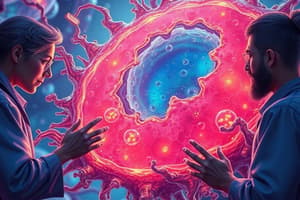Podcast
Questions and Answers
Which scientist is known for coining the term 'cell'?
Which scientist is known for coining the term 'cell'?
- Robert Hooke (correct)
- Robert Brown
- Mathias Schliden
- Anton van Leeuwenhoek
What did Anton van Leeuwenhoek observe that later became known as bacteria?
What did Anton van Leeuwenhoek observe that later became known as bacteria?
- Pollen grains
- Animalcules (correct)
- Cells
- Nucleus
Which scientist proposed that cells are the basic unit of life in plants?
Which scientist proposed that cells are the basic unit of life in plants?
- Robert Brown
- Theodor Schwann
- Rudolf Virchow
- Mathias Schliden (correct)
What important concept did Rudolf Virchow introduce regarding diseased cells?
What important concept did Rudolf Virchow introduce regarding diseased cells?
What observation did Robert Brown make while studying plant cells?
What observation did Robert Brown make while studying plant cells?
What is the main function of the endoplasmic reticulum in liver cells?
What is the main function of the endoplasmic reticulum in liver cells?
Which structure primarily modifies and transports substances produced by the endoplasmic reticulum?
Which structure primarily modifies and transports substances produced by the endoplasmic reticulum?
What is the primary role of mitochondria in the cell?
What is the primary role of mitochondria in the cell?
What is the function of lysosomes in an animal cell?
What is the function of lysosomes in an animal cell?
Which structure is crucial for cell division by producing spindle fibers?
Which structure is crucial for cell division by producing spindle fibers?
What are the primary components of the plant cell wall?
What are the primary components of the plant cell wall?
Which pigment is essential for photosynthesis in chloroplasts?
Which pigment is essential for photosynthesis in chloroplasts?
What type of movement is facilitated by cilia in the cytoskeleton?
What type of movement is facilitated by cilia in the cytoskeleton?
What is the primary role of the nucleus in a eukaryotic cell?
What is the primary role of the nucleus in a eukaryotic cell?
Which of the following statements accurately describes prokaryotic cells?
Which of the following statements accurately describes prokaryotic cells?
What structure is responsible for producing ribosomes within the nucleus?
What structure is responsible for producing ribosomes within the nucleus?
Which statement is true about the Rough Endoplasmic Reticulum (RER)?
Which statement is true about the Rough Endoplasmic Reticulum (RER)?
What is the role of cytoplasm within the cell?
What is the role of cytoplasm within the cell?
What distinguishes smooth endoplasmic reticulum from rough endoplasmic reticulum?
What distinguishes smooth endoplasmic reticulum from rough endoplasmic reticulum?
Why are red blood cells considered anucleate?
Why are red blood cells considered anucleate?
Which of the following is a characteristic of eukaryotic cells?
Which of the following is a characteristic of eukaryotic cells?
Flashcards
Who was Robert Hooke?
Who was Robert Hooke?
English polymath who first coined the term "cell" while observing cork under a microscope in 1665. He described the small compartments he saw as "cellula", Latin for small room.
Who was Anton van Leeuwenhoek?
Who was Anton van Leeuwenhoek?
Dutch microbiologist known as the "Father of Microscopy" for his observations of living cells in the 1680s. He was the first to observe single-celled organisms, which he named "animalcules" (later recognized as bacteria).
Who was Robert Brown?
Who was Robert Brown?
Scottish botanist who observed the nucleus in plant cells while studying pollen grains in 1831. This discovery contributed to the understanding of plant cells.
Who was Matthias Schleiden?
Who was Matthias Schleiden?
Signup and view all the flashcards
Who was Theodor Schwann?
Who was Theodor Schwann?
Signup and view all the flashcards
Prokaryote
Prokaryote
Signup and view all the flashcards
Eukaryote
Eukaryote
Signup and view all the flashcards
Organelle
Organelle
Signup and view all the flashcards
Nucleus
Nucleus
Signup and view all the flashcards
Endoplasmic Reticulum (ER)
Endoplasmic Reticulum (ER)
Signup and view all the flashcards
Rough Endoplasmic Reticulum (RER)
Rough Endoplasmic Reticulum (RER)
Signup and view all the flashcards
Smooth Endoplasmic Reticulum (SER)
Smooth Endoplasmic Reticulum (SER)
Signup and view all the flashcards
Ribosome
Ribosome
Signup and view all the flashcards
Golgi Apparatus
Golgi Apparatus
Signup and view all the flashcards
Mitochondria
Mitochondria
Signup and view all the flashcards
Vacuoles
Vacuoles
Signup and view all the flashcards
Lysosomes
Lysosomes
Signup and view all the flashcards
Centrioles
Centrioles
Signup and view all the flashcards
Cytoskeleton
Cytoskeleton
Signup and view all the flashcards
Cell Wall
Cell Wall
Signup and view all the flashcards
Study Notes
Biologists and Cell Theory
- Robert Hooke (1665): Coined the term "cell" while observing cork under a microscope.
- Anton van Leeuwenhoek (1680s): Observed living cells, and single-celled organisms, credited as the "Father of Microscopy."
- Robert Brown (1831): Identified the nucleus in plant cells, contributing to cell theory.
- Mathias Schleiden (1838): Proposed that cells are the fundamental units of plant life.
- Theodor Schwann (1839): Expanded Schleiden's theory to include animal cells, stating that all animals are composed of cells.
- Rudolf Virchow (1858): Contributed by proposing that all living cells come from pre-existing cells, opposing spontaneous generation.
Domains of Life
- Prokaryotes:
- Bacteria and Archaea
- Single-celled microorganisms
- Lack a nucleus
- Simple structure
- Eukaryotes:
- Complex organisms
- Single-celled or multicellular
- Have a nucleus
- More complex structure.
Organelles
- Organelle: Specialized structures within eukaryotic cells with specific functions. Contributes to cell activity.
- Nucleus: Membrane-bound organelle containing genetic information (chromosomes) that regulates cell function and division.
- Nuclear envelope: Separates the nucleus from the cytoplasm, supporting the nucleus structure.
- Nucleolus: Produces ribosomes.
- Chromatin: Thread-like structures made of DNA, forms chromosomes when condensed.
- Cytoplasm: Cell's inner substance outside the nucleus.
- Endoplasmic Reticulum (ER): Network of tubules and flattened sacs assisting in material transport within the cell.
- Smooth ER: Synthesizes lipids and steroids and assists with detoxification.
- Rough ER: Synthesizes proteins and has ribosomes attached.
- Ribosomes: Small structures responsible for protein synthesis, either free or attached to ER.
- Golgi Apparatus: Processes, modifies, and packages proteins and other materials.
- Mitochondria: Organelles responsible for energy production (ATP).
- Vacuoles: Fluid-filled sacs that store nutrients, water, waste. Animal cells often have smaller vacuoles than plant cells
- Lysosomes: Specialized vacuoles with enzymes for breaking down waste materials.
- Cell Wall: Found in plant cells, provides support, made of cellulose.
- Chloroplast: Found in plant cells, contains chlorophyll enabling photosynthesis.
Specialized Structures in Animal Cells
- Centrioles: Involved in cell division by producing spindle fibers and ensuring equal chromosome distribution.
- Cytoskeleton: Maintains cell shape and assists in movement (e.g., cilia, flagella).
- Cilia: Short hair-like structures used for rapid movement/
- Flagella: Long, whip-like structures used for movement
Studying That Suits You
Use AI to generate personalized quizzes and flashcards to suit your learning preferences.




